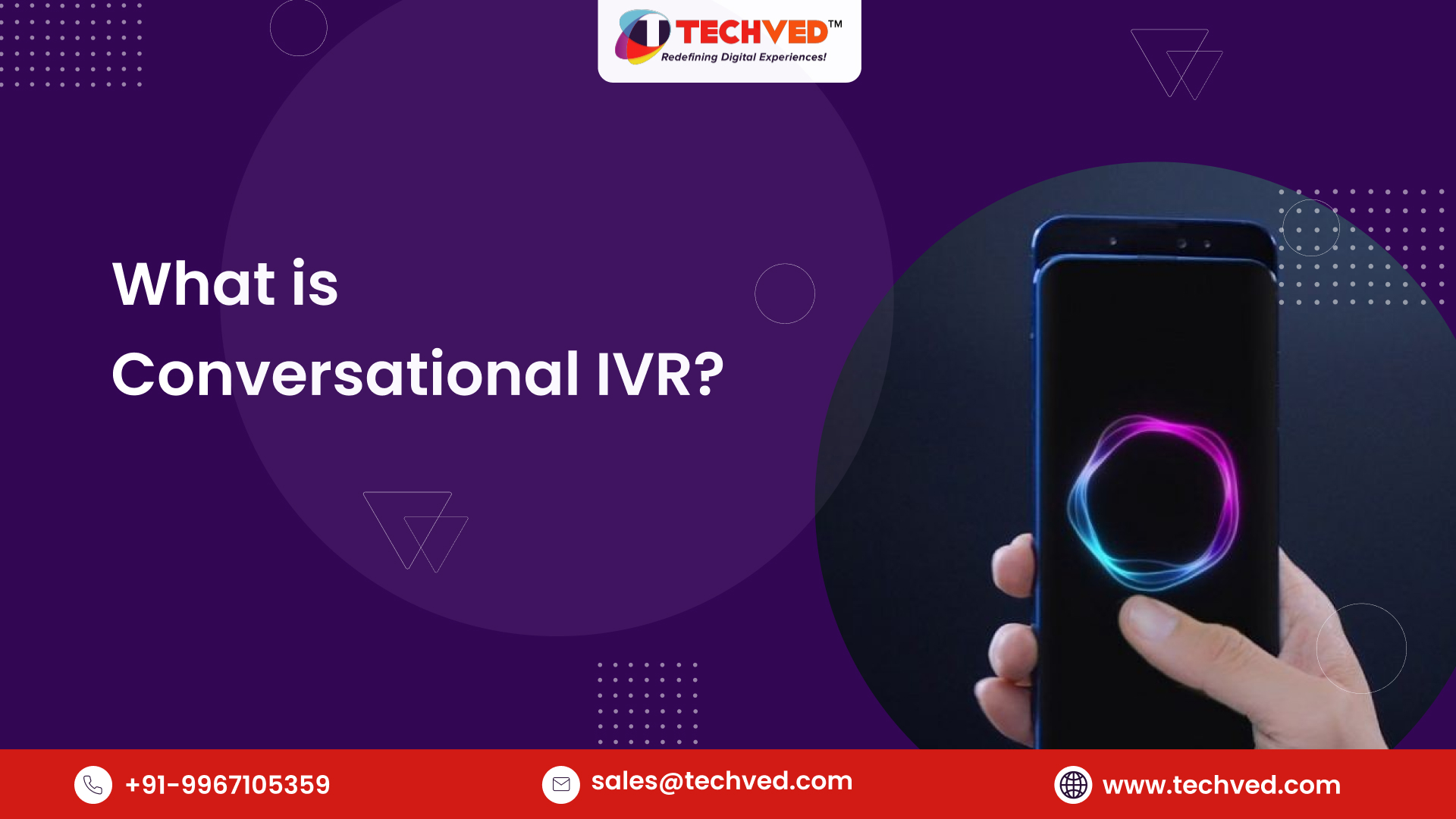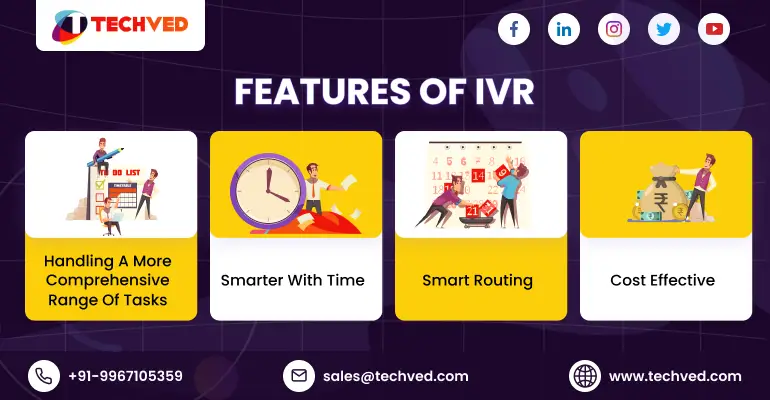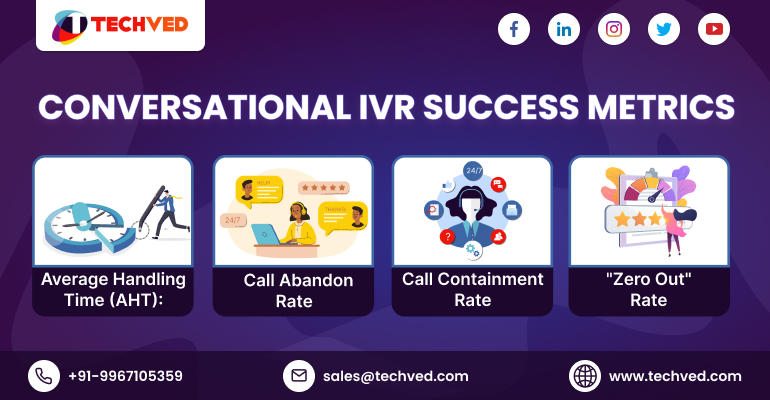Today technology is becoming invasive, and with the advancement of technology customer expectations are also changing. Enterprises have recognized that customer satisfaction/engagement plays an imperative role in business growth. According to a research, 61% of customers stopped doing business with a brand because of poor customer service experience. Interactive Voice Response (IVR) has been a crucial technology for customer support since years. A survey conducted by IBM showed that enterprises across the globe spend $1.3 trillion on 265 billion customer service calls every year. However, longer waiting times and the repetitive spree of pressing the numbers according to the recorded voice to get to the choice-able menu frustrates the consumers on a greater level.
Let’s get to know conversational IVR meaning more better. IVR stands for Interactive Voice Response, which is a way of receiving voice as input and responding with speech.
IVRs that can process speech as input are conversational IVR platform. This means they can receive and process speech as input. They should also be able to respond with spoken words by either pre-recorded or dynamically generated speech.
In most cases, with traditional IVR, a customer tends to drop their call before reaching the desirable menu or the customer support executive. The necessity for intelligent management of increasing calls and lowering human dependency has ignited AI's application in the IVR system in the past few years. It became essential to spare the burden of overwork from the agents by an intelligent solution, entering the concept & leveraging the Conversational IVR benefits.
This article will provide a comprehensive overview of conversational IVR, and an insight into how enterprises are implementing this technology.
Key Takeaways from this Article
To understand Conversational IVR definition
How it is overcoming limitations of the traditional IVR?
How enterprises are implementing this?
Possible obstacles during implementation
Identifying the appropriate metrics to measure success
What is Conversational IVR?

It's a voice-driven customer self-service that uses NLU (Natural Language Understanding) to grasp the context and content of speech.
Conversational IVR is Overcoming the Limitations of Traditional IVR
Even today, 39% of the people consider phone calls to the contact center as the best option to make initial contact for any support. While in the case of traditional IVR, a pre-recorded voice rattles off multiple interlinked options causing prolonged waiting time, this leads to call drops. This conventional system's major drawback is that one needs to start from the beginning for any miss-pressed button in between, resulting in user frustration. Conversational IVR framework helps us overcome all these in various ways.
Here are few features of IVR:

Handling a more comprehensive range of tasks
With minimal human intervention, it works more efficiently in less time than the traditional Interactive Voice Response(IVR). It automatically transfers the call to the respective customer care executive when unable to understand a query, resulting in less confusion and waiting time. It can also provide advice on the brand's services and products.
Smarter With Time
It routes the unknown query to the concerned person and records the question and its response. It doesn't need the routing for the same query from next time onwards and can resolve it automatically. Thus, the data training algorithm behind it makes the IVR smarter with time.
Smart Routing
With traditional IVR systems, it's a headache and time-consuming to reach the desired department/contact person. Most of the time, call drop happens due to prolonged waiting time. Automation in IVR resolves this problem quickly. The algorithm can examine and comprehend the flow of statements and thus allocate the right person to the customer after detecting the intention of customers. Data shows that call routing accuracy has been increased by 50% with the help of conversational AI IVR.
Cost Effective
Effective Conversational IVR decreases the Average Handling Time (AHT) and is less expensive than the traditional options available, and it also maximizes agent productivity.
Enterprises Leveraging Conversational IVR Across the Globe

Giant enterprises are changing their traditional IVR into an automated one, and the data proves its benefits readily.
The features of IVR are going to change the way businesses function, so you better stay on top of things.
Here are a few Conversational IVR Example & Conversational AI IVR implementations:
FedEx has humanized its IVR System
Realizing the lag in the IVR system, FedEx decided to implement conversational IVR for their customer support. The aim was to make a seamless process for the consumers and bring multiple North American contact centers together on a platform. The results were brilliant. The humanized system seamlessly now guides the callers through scheduling a pickup, tracking packages, getting rates, and even ordering supplies, and that too without a support agent's help. It increases the automation by 6%; percentage of per day eliminated calls to live agents: 11000; and two languages (English & Canadian French) are supported.
QNB Finansbank boosted Customer Satisfaction
Qatar National Bank Finansbank, which has 525 branches in Turkey, implemented this technology will improve their overall customer experience. Receiving almost 100k calls per day, the bank faced a vast workload problem for 600 full-time customer support employees with a 3 minutes average of lasting calls. After humanizing the Interactive Voice Response(IVR) system, the average waiting time decreased by 31%, menu accuracy increased by 92%, abandoned calls fell by 39%, and agent workload decreased by 10%.
Key Point to consider before Implementation - Possible Obstacles
Implementation of an idea takes a lot of reality checks and constraint considerations. Transforming the traditional IVR system into an AI one also has its fair share of challenges. Any enterprise should consider all the obstacles before changing an entire system. Humanized Interactive Voice Response algorithms mainly depend on the training data, but the data tends to get obsolete after a particular time or in specific cases. Voices could be of the same language but with different accents and styles, and in that case, matching voice every time with existing data or recording new data for training purposes could be challenging. In such cases, the system should be designed in such a way that it can work with both, text and voice inputs.
Identifying Appropriate Metrics to Measure Success
It's essential to track data on different metrics to measure the improvement of the conversational IVR and compare it periodically with the traditional system data before transforming a system altogether.
Here are a few metric to look into:

Average Handling Time (AHT)
The average duration of a call from the beginning to completion, including the IVR navigation, wait time, and agent interaction. It can indicate IVR issues and agent performance and is an essential parameter for analyzing the system.
Call Abandon Rate
It is the percentage of inbound calls abandoned by customers before reaching a support agent. A high call abandonment rate is an indicator of unhappy customers.
Call Containment Rate
It's a measure of the self-service facility by the IVR. It is the percentage of inbound calls that are taken care of by the IVR. A poor call containment rate describes a poorly configured IVR.
"Zero Out" Rate
It means bypassing the IVR and contacting an agent directly due to prolonged wait time or frustration by layered options. It's a key indicator of poor IVR performance. So, it's critical to measure all the metrics to understand the loopholes, be it in the IVR configuration or in the training of agents to enhance the business performance.
Conclusion
Undoubtedly, the future of conversational IVR is all about voice interactions and automated technology, and the contact centers are no exception. These IVR features & benefits are going the change the way business operate. According to a research, 66% of customers try to use self-service in customer support calls. So, being the crucial part of any business, contact centers should focus more on automated conversational technology to improve productivity, efficiency, and customer satisfaction.
FAQS
1. Which are the key features of IVR?
Cloud-Based Hosting
IVR systems housed in the cloud can be remotely managed by contact centre managers, which saves on staff technical work. Using application programming interfaces, they might potentially incorporate it with additional tools (APIs).
AI-Based Speech Recognition
Artificial intelligence (AI) is a feature of contemporary IVR systems that enables voice-only system navigation by the user. In order to do this, it can separate spoken language into audio units known as phonemes, which are then matched with a particular text to extract meaning.
Visual IVR Configuration
IVR systems can be set up via visual dashboards or scripts. The latter frequently employs a no-code methodology, allowing designers to drag and drop the IVR design into position using a straightforward graphical user interface (GUI).
End-to-End Self-Service
End-to-end self-service indicates that a task can be completed entirely by customers using an IVR without the assistance of a human agent. It processes whole jobs within the conversation flow rather of just relaying information, as an on-hold message might, or instructing the consumer which number to push for which department. These might be delivery updates, feedback collection, or order cancellations.
Multilingual IVR
Companies can want to deliver IVR in a variety of languages depending on where they are. IVR skills in all of the major world languages are occasionally needed by international organizations.
2. How does IVR system works?
When phoning a contact centre, customers will first come across IVR. The IVR will play a taped message to welcome the caller and then present them with a number of menu alternatives. For instance, users will be instructed to press 1 or say "Service" to reach the service department, 2 or say "Sales" to reach the sales department, and so on. Inbound calls are handled via IVR. You can configure your IVR based on certain business requirements, improve teamwork, and produce a polished client experience.
3. What are the types of customer support?
Customer support is all about keeping your customers happy, and there are a lot of different types of customer services out there. We've listed the most common ones below:
1. Walk-in service departments
2. Phone and email support
3. Support via live chat
4. Self-service content
5. Communities and forums
4. How Conversational IVR helps business to grow?
It stands for the Interactive Voice Response System, and it's an automated way to handle customer service calls. The benefit of conversational IVR is that it saves money. It allows you to make changes quickly—you can add or change features on your site with just a few clicks. Because of this, conversational IVR is more efficient than live agents in the sense that you don't have to hire as many people or spend as much money on training them. It also improves customer satisfaction and when you company offers such an easy way for customers to get questions answered quickly and efficiently, then you've got yourself a happy customer base that'll stick around longer than average!